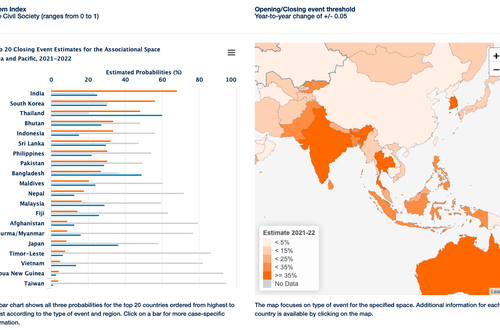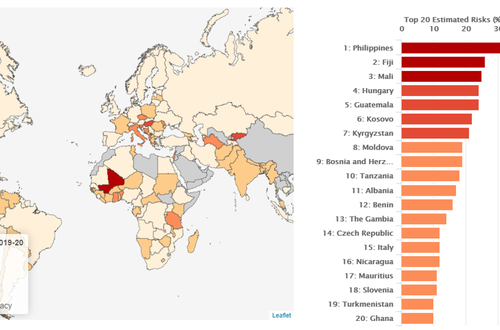V-Forecast
The V-Forecast project is the Varieties of Democracy (V-Dem) Institute’s forecasting intuitive. We offer two online forecasting tools: DemSpace and Predicting Adverse Regime Transitions (PART)
DemSpace
The Democratic Space Barometer is the product of a collaboration between Andreas Beger (Predictive Heuristics), Laura Maxwell (former Research Fellow at V-Dem), and Rick Morgan (Former Postdoc at V-Dem). A public repository of the code we use to generate our forecasts and develop this dashboard can be found here.
The six conceptual dimensions we focus on come from the International Republican Institute's Closing Space Barometer, which includes an analytical framework for assessing the processes that facilitate a substantial reduction (closing events) within these six spaces. This framework was developed based on a series of workshops conducted with Democracy, Human Rights, and Governance (DRG) donors and implementing partners in 2016 and represent the conceptual features of democratic space which are most amenable to DRG assistance programs.
We adapted these conceptual spaces, expanded the scope to include substantial improvements (opening events), and developed an operationalization method to identify opening and closing events within each space. This dashboard, and the forecast that drive it, is the output of these efforts.
The Democratic Space Barometer estimates the probability that a country will experience at least one opening event (shift towards more democratic governance) or at least one closing event (shift towards more autocratic governance) within a two-year window (2020-2021). We estimate the probability of opening and closing events across six spaces of democratic governance:
- Associational
- Economic
- Electoral
- Governing
- Individual, and
- Informational.
From year to year, these spaces can open (liberalize) or close (autocratize). To capture these events, we focus on year-to-year changes within the V-Dem indices we identify for each space.
We classify opening (closing) events as year-to-year increases (decreases) in a country's V-Dem index score greater than (less than) or equal to an empirically defined threshold that is unique for each space – six thresholds altogether.
We use a set of 12 random forest classification models and a country-year dataset with global coverage (169 countries) from 1970-2019 to derive our risk estimates. Please see our working paper for more information on our measurement and modeling strategies.
Predicting Adverse Regime Transitions (PART)
In the initial year of the V-Forecast project, we provided two-year ahead Predicting Adverse Regime Transitions (PART) for 169 countries. PARTs are substantial movements of a country’s regime towards more authoritarian governance, whether authoritarian reversals in a democracy, or further autocratization in an already nondemocratic country. We operationalize PARTs as a year-to-year decrease in the Regimes of the World index.
To produce our two-year ahead predictions, we use the output from three machine learning algorithms – logit with elastic-net regularization, random forest, and gradient-boosted forests – in an unweighted ensemble model. These machine learning models have access to a data set of over 400 variables. Despite being rare events, with a roughly four percent baseline chance over any two-year period, in test forecasts the model is able to achieve good accuracy.
By developing these models and by making these risk assessments public and interpretable, this project hopes to provide useful tools for policy-makers and aid agencies. To this end, we have developed an interactive web application that allows users to see risk assessments for all countries. This web application allows users to view the estimated risk of regime change within the two-year window as well as evaluate time trends across select V-Dem indices for a specific country.
Providing accurate estimates of a country’s risk of experiencing a an adverse regime change is only the first step. The V-Forecast team is in the process of developing a series of estimated risk models for a number of different phenomena associated with autocratization.



